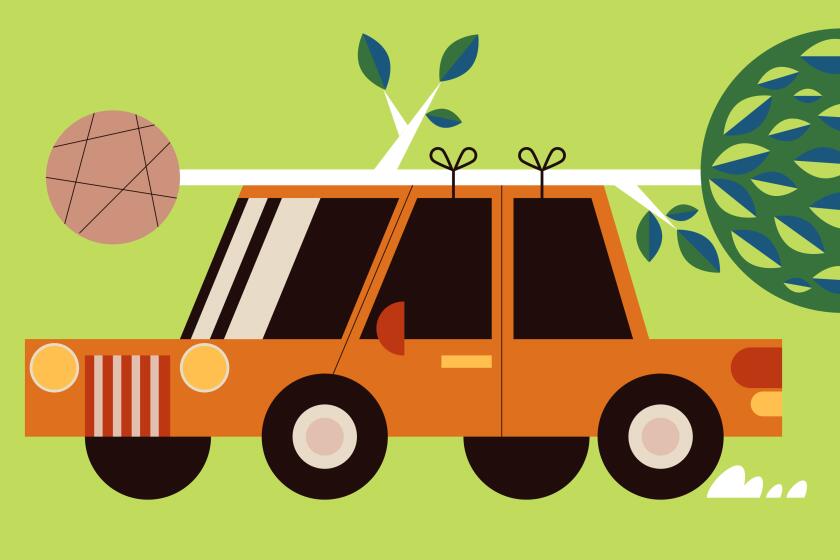A new lay of the land at Pepperdine
From atop Pepperdine University’s hilly seaside campus, Californians’ changing approach to the local landscape is dramatically apparent.
The school’s older lower campus is a sweeping green expanse of lawn set with decorative, often nonnative trees, all irrigated by Pepperdine’s own treated wastewater.
Above, the dry slopes surrounding the newer 49-acre Drescher Graduate Campus are devoid of any signs of foreign lushness. Instead, university landscapers have gone to great lengths to integrate the upper campus into the wild native hillside from which it was carved.
“Our goal is to insert this campus into the natural, beautiful Santa Monica Mountains habitat,” said Rick Leach, director of facilities management and planning. “In a normal landscaping job, ground cover should exist in 90 days. This, however, is a 10-year project to get good cover on all the slopes. Talk about shifting your paradigm.”
Basically, the method replants the slopes with seeds and soil collected by hand from the site seven years ago, before grading began. The hand selection also allowed landscapers to eliminate any nonnative plant species that had invaded the site.
“A lot of work was done before development to see what was here,” Leach said. “Then we took the seeds and stored them under ideal conditions. The good news is native seeds have a very long shelf life. We wanted to maintain the purity of what was here, to keep the exact same plants in the area, all of them Santa Monica Mountains natives.”
Workers collected not only seeds but soil that had eroded from the hillside. It was mixed with composted chips from campus trees and stuffed into biodegradable burlap sacks. The sacks were placed on slopes and packed into rivulets that development had left bare.
“Their job is to reinaugurate a topsoil, and we hand-seed over the top of them,” Leach said. “Native seeds need to have direct contact with the soil, so we spread a mulch over them to keep them in contact, and also to protect them from birds and other things that might regard them as a free lunch.”
Stephen Davis, distinguished professor of biology at Pepperdine, said the use of native soil from the site is critical to the reestablishment and future vigor of the native plants. That soil, he said, contains fungal and nitrogen-fixing organisms that are specifically symbiotic with the local native plants.
The method “works out really, really well,” said Douglas Failing, Los Angeles director for the California Department of Transportation, which for more than two decades has used it to re-vegetate hillsides affected by massive highway construction projects. “All seeds and plants differ from each other when you go from microclimate to microclimate. With this you know you’ve got seeds and plants that are going to be compatible with what’s out there already.”
Caltrans has employed the method widely throughout the state. About 90% of the plants the agency has used in restoration projects have been native, according to agency spokesman David Anderson.
Whether to re-vegetate with native or nonnative species in the areas of Griffith Park burned in the recent brush fire is under official discussion. Some of the most scenic areas that were scorched had contained nonnatives.
Peigi Duvall, horticulture director for the California Native Plant Society, said the trend toward drought-resistant native flora has become a “big groundswell,” not only among designers of public and institutional projects but in commercial and residential landscaping. “People know you can’t just water endlessly,” she said.
David Fross, owner of Native Sons nursery, an Arroyo Grande, Calif., wholesaler of native plants, said the trend is being fueled not just by economics but by a growing public understanding that California’s environment is unique.
“People are just coming to grips with recognizing this is not the East Coast,” he said. “You can call any nursery with a strong line of native plants and they have all seen increased demand in the last 10 years.”
On Pepperdine’s upper slopes, where the burlap sandbags are going about their slow business of soil formation, irrigation pipes are noticeably absent. Once native plants are reestablished, there will be no need for artificial watering.
Leach pointed out those portions of the slopes, with their dense, green chaparral, that were left untouched by development of the Drescher campus.
“These sumac plants will still be green in August, even though they haven’t had a drop of water for eight months,” he said.
When Pepperdine biology students tried to excavate some of the mature plants, they discovered that their roots went 30 feet deep. “That’s how they stay green,” Leach said. “Up here, we’re dry-land farmers. If we were to irrigate these slopes, we’d completely mess up the plants’ life cycles.”
Unlike the green lower campus, the upper campus’ landscape, once reestablished, will essentially be self-sustaining. Reduced maintenance costs, Leach said, comport nicely with concerns about water availability in the region, as well as with people’s increasing sensitivity to working with Southern California’s natural ecosystems.
California, Davis said, remains “a hot spot of biodiversity that is threatened by human activities such as increasing fire frequency, development, vegetation-type conversion and the introduction of invasive, weedy species.... With current concerns about climate change and record drought events, native plants in the landscape are more attractive and desirable than ever.”
Ironically, Pepperdine’s attempt to reestablish a drought-tolerant landscape has been thwarted this year -- by drought.
Even native seeds require winter rains to develop roots. This winter, the campus received only 20% of its normal rainfall, so landscapers decided not to sow any additional seeds.
“We were hoping for a normal year this year to speed the project along,” Leach said. “Now, of course, it’s slowing down.”
*






